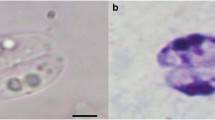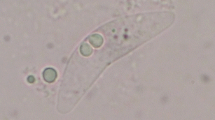Abstract
Purpose
Two myxosporean species have been, so far, independently reported from the gallbladder of the European pilchard, Sardina pilchardus (Walbaum) (synonym Clupea pilchardus) in the Northern shore of the Mediterranean Sea; Ceratomyxa truncata Thélohan, and Coccomyxa morovi Léger and Hesse, 1907. The two species were described with incomplete morphological data and based only on line drawings of their mature myxospores.
Methods
During a parasitological survey in the Southern shores of the Mediterranean coast in the gulf of Gabès off Tunisia, two coelozoic myxosporean species were found in the European pilchard and described using morphological and molecular phylogenetic tools. Morphological characterization was based on the mature myxospore study and some vegetative stages. The SSU rDNA sequences were performed for molecular and phylogenetic study.
Results
The most frequently encountered species belongs to the genus Ceratomyxa Thelohan, 1892. The second species belongs to the genus Coccomyxa. Morphological examinations, allowed us to match these two recorded species with Ceratomyxa truncata and Coccomyxa morovi, respectively, as previously described in the same host species referring to the original manuscripts instead of some morphological differences. Molecular analyses based on the partial SSU rDNA sequences did not much with any of the previously reported myxozoan sequences. Phylogenetic analysis positioned C. truncate in a well-supported clade including Ceratomyxa ssp. from Mediterranean Sea, while C. morovi was positioned on the basis of the subclade grouping all Coccomyxidae species.
Conclusion
We provided herein a first morphological redescription of Ceratomyxa truncata and Coccomyxa morovi parasite of Sardina pilchardus from the Southern shores of the Mediterranean Sea and we successfully obtained the SSU rDNA sequences of these two species and positioned them in the phylogenetic tree.



Similar content being viewed by others
References
Kent ML, Andree KB, Bartholomew JL, El-Matbouli M, Desser SS, Devlin RH et al (2001) Recent advances in our knowledge of the Myxozoa. J Eukaryot Microbiol 48(4):395–413
Fiala I, Bartošová-Sojková P, Okamura B, Hartikainen H (2015) Adaptive radiation and evolution within the Myxozoa. In: Okamura B, Gruhl A, Bartholomew JL (eds) Myxozoan evolution, ecology and development. Springer International Publishing, Cham, pp 69–84
Fiala I, Hlavnickova M, Kodadkova A, Freeman MA, Bartosova-Sojkova P, Atkinson SD (2015) Evolutionary origin of Ceratonova shasta and phylogeny of the marine myxosporean lineage. Mol Phylogenet Evol 86:75–89
Canning EU, Okamura B (2004) Biodiversity and evolution of the Myxozoa. Adv Parasitol 56:43–131
Holzer AS, Bartosova-Sojkova P, Born-Torrijos A, Lovy A, Hartigan A, Fiala I (2018) The joint evolution of the Myxozoa and their alternate hosts: A cnidarian recipe for success and vast biodiversity. Mol Ecol 27(7):1651–1666. https://doi.org/10.1111/mec.14558
Shpirer E, Diamant A, Cartwright P, Huchon D (2018) A genome wide survey reveals multiple nematocyst-specific genes in Myxozoa. BMC Evol Biol 18(1):138–138. https://doi.org/10.1186/s12862-018-1253-7
Foox J, Siddall ME (2015) The road to cnidaria: history of phylogeny of the Myxozoa. J Parasitol 101(3):269–274
Atkinson SD, Bartholomew JL, Lotan T (2018) Myxozoans: ancient metazoan parasites find a home in phylum Cnidaria. Zoology 129:66–68. https://doi.org/10.1016/j.zool.2018.06.005
Evans NM, Holder MT, Barbeitos MS, Okamura B, Cartwright P (2010) The phylogenetic position of Myxozoa: exploring conflicting signals in phylogenomic and ribosomal data sets. Mol Phylogenet Evol 27(12):2733–2746. https://doi.org/10.1093/molbev/msq159
Okamura B, Hartigan A, Naldoni J (2018) Extensive uncharted biodiversity: the parasite dimension. Integr Comp Biol 58:1132–1145
Ji L, Dyková I (1992) Protozoan parasites of fishes. Elsevier, Amsterdam, New York
Lom J, Dykova I (2006) Myxozoan genera: definition and notes on taxonomy, life-cycle terminology and pathogenic species. Folia Parasitol (Praha) 53(1):1–36
Santojanni A, Cingolani N, Arneri E, Kirkwood G, Belardinelli A, Giannetti G et al (2005) Stock assessment of sardine (Sardina pilchardus, Walb) in the Adriatic Sea with an estimate of discards. Sci Mar 69(4):603–617
Gaamour A, Khemiri S (2010) Evaluation of growth differences in populations of Sardina pilchardus (Walbum, 1792) from two regions along the Tunisian costs. Cah Biol Mar 51:101–108
Thélohan P (1895) Recherches sur les Myxosporidies. Bull Sci Fr Belg 5:100–394
Léger H, Hesse E (1907) Sur une nouvelle Myxosporidie parasite de la sardine. C R Acad Sci Paris 145:85–87 (in Frensh)
Lom J, Arthur J (1989) A guideline for the preparation of species descriptions in Myxosporea. J F Dis 12(2):151–156
Mansour L, Thabet A, Chourabi K, Harrath AH, Gtari M, Al Omar SY et al (2013) Kudoa azevedoi n. sp. (Myxozoa, Multivalvulida) from the oocytes of the Atlantic horse mackerel Trachurus trachurus (Perciformes, Carangidae) in Tunisian coasts. Parasitol Res 112(4):1737–1747. https://doi.org/10.1007/s00436-013-3332-4
Ward RD, Zemlak TS, Innes BH, Last PR, Hebert PDN (2005) DNA barcoding Australia’s fish species. Philos Trans R Soc Lond B Biol Sci 360(1462):1847–1857. https://doi.org/10.1098/rstb.2005.1716
Altschul SF, Madden TL, Schaffer AA, Zhang J, Zhang Z, Miller W et al (1997) Gapped BLAST and PSI-BLAST: a new generation of protein database search programs. Nucleic Acids Res 25(17):3389–3402
Larkin MA, Blackshields G, Brown NP, Chenna R, McGettigan PA, McWilliam H et al (2007) Clustal W and Clustal X version 2.0. Bioinformatics 23(21):2947–2948. https://doi.org/10.1093/bioinformatics/btm404
Ronquist F, Teslenko M, van der Mark P, Ayres DL, Darling A, Hohna S et al (2012) MrBayes 3.2: efficient Bayesian phylogenetic inference and model choice across a large model space. Syst Biol 61(3):539–542
Kumar S, Stecher G, Tamura K (2016) MEGA7: molecular evolutionary genetics analysis version 7.0 for bigger datasets. Mol Biol Evol 33(7):1870–1874
Kpatcha TK, Diebakate C, Faye N, Toguebaye BS (1996) Quelques nouvelles espèces de Myxosporidies, du genre Ceratomyxa Thélohan, 1895 parasites des poissons marins du Sénégal, Afrique de l’Ouest. Parasite (Paris, France) 3(3):223–228
Gaevskaya A, Kovaleva A (1979) New and rarely occurring myxosporidia species from the Celtic Sea fishes. Parazitologiya 13:159–165 (in Russian)
Gunter NL, Burger MA, Adlard RD (2010) Morphometric and molecular characterisation of four new Ceratomyxa species (Myxosporea: Bivalvulida: Ceratomyxidae) from fishes off Lizard Island, Australia. Folia Parasitol (Praha) 57(1):1–10
Fiala I, Sojková P, Whipps C (2015) Classification and phylogenetics of Myxozoa. In: Gruhl A, Bartholomew JL, Okamura B (eds) Myxozoan evolution, ecology and Development. Springer, Cham, pp 85–110
Heiniger H, Adlard RD (2014) Relatedness of novel species of Myxidium Butschli, 1882, Zschokkella Auerbach, 1910 and Ellipsomyxa Koie, 2003 (Myxosporea: Bivalvulida) from the gall bladders of marine fishes (Teleostei) from Australian waters. Sys parasit 87(1):47–72. https://doi.org/10.1007/s11230-013-9454-3
Mansour L, Harrath AH, Abd-Elkader OH, Alwasel S, Abdel-Baki AA, Al Omar SY (2014) Structural and molecular characterization of Kudoa quraishii n. sp. from the trunk muscle of the Indian mackerel Rastrelliger kanagurta (Perciforme, Scombridae) in Saudi Arabia coasts. Parasitol Res 113(4):1361–1370. https://doi.org/10.1007/s00436-014-3775-2
Abdel-Baki AAS, Al-Qahtani HA, Almalki E, Al-Quraishy S, Al Ghamdi A, Mansour L (2018) Morphometeric criteria and partial sequence of the 18S rRNA gene of Ceratomyxa sultani n. sp. from the gallbladder of Upeneus margarethae in the Arabian Gulf, with a note on its seasonal prevalence. Saudi J Biol Sci 25(3):597–603. https://doi.org/10.1016/j.sjbs.2017.12.001
Thabet A, Tlig-Zouari S, Al Omar SY, Mansour L (2016) Molecular and morphological characterisation of two species of the genus Ellipsomyxa Køie, 2003 (Ceratomyxidae) from the gall-bladder of Liza saliens (Risso) off Tunisian coasts of the Mediterranean. Sys parasitol 93(6):601–611. https://doi.org/10.1007/s11230-016-9647-7
Mansour L, Azevedo C, Alves Â, Al-Quraishy S, Abdel-Baki A-AS (2017) Ultrastructural aspects and molecular phylogeny of Auerbachia maamouni n. sp. (Myxosporea: Bivalvulida) from the gallbladder of Gnathanodon speciosus Forsskål (Actinopterygii: Carangidae) in the Red Sea. Syst parasitol 94(1):123–131. https://doi.org/10.1007/s11230-016-9684-2
Thabet A, Abdel-Baki A-AS, Harrath AH, Mansour L (2019) Morphological and molecular aspects of Ceratomyxa ghannouchensis n. sp. and C. pallida Thélohan 1894 infecting the bogue, Boops boops (l.). J Nat Hist 53(9–10):541–556. https://doi.org/10.1080/00222933.2019.1597202
Whipps CM, El-Matbouli M, Hedrick RP, Blazer V, Kent ML (2004) Myxobolus cerebralis internal transcribed spacer 1 (ITS-1) sequences support recent spread of the parasite to North America and within Europe. Dise Aquatic Org 60(2):105–108
Liu Y, Gu Z, Zhang Y, Zeng L (2011) Redescription and molecular analysis of Myxobolus shantungensis Hu, 1965 (Myxozoa: Myxosporea) infecting common carp Cyprinus carpio haematopterus. Parasitol Res 109(6):1619–1623. https://doi.org/10.1007/s00436-011-2450-0
Zhao YJ, Li NN, Tang FH, Dong JL (2013) Remarks on the validity of Myxobolus ampullicapsulatus and Myxobolus honghuensis (Myxozoa: Myxosporea) based on SSU rDNA sequences. Parasitol Res 112(11):3817–3823. https://doi.org/10.1007/s00436-013-3569-y
Whipps CM, Grossel G, Adlard RD, Yokoyama H, Bryant MS, Munday BL et al (2004) Phylogeny of the multivalvulidae (Myxozoa: Myxosporea) based on comparative ribosomal DNA sequence analysis. J parasitol 90(3):618–622. https://doi.org/10.1645/ge-153r
Griffin MJ, Goodwin AE (2011) Thelohanellus toyamai (Syn. Myxobolus toyamai) infecting the gills of Koi Cyprinus carpio in the Eastern United States. J Parasitol 97(3):493–502. https://doi.org/10.1645/ge-2674.1
Heiniger H, Gunter NL, Adlard RD (2011) Re-establishment of the family Coccomyxidae and description of five novel species of Auerbachia and Coccomyxa (Myxosporea: Bivalvulida) parasites from Australian fishes. Parasitol 138(4):501–515. https://doi.org/10.1017/S0031182010001447
Chaganti K, Mackenzie K (1999) The genera Ceratomyxa Thelohan, 1892, Leptotheca Thelohan, 1895 and Sphaeromyxa Thelohan, 1892 (Myxosporea: Bivalvulida) in gadid fish of the Northeast Atlantic. Syst Parasitol 43:209–216. https://doi.org/10.1023/A:1006144721096
Laamiri S (2014) New observations on Myxozoa of the goldline sea bream Sarpa salpa L. 1758 (Teleostei: Sparidae) from the Mediterranean coast of Tunisia. Zootaxa 3887(2):157–190. https://doi.org/10.11646/zootaxa.3887.2.3
Sojková P, Lövy Kodádková A, Reed C, Lisnerová M, Tomková T, Holzer A et al (2018) Life in a rock pool: radiation and population genetics of myxozoan parasites in hosts inhabiting restricted spaces. PLoS ONE 13:e0194042. https://doi.org/10.1371/journal.pone.0194042
Lom J, Noble RE (1984) Revised classification of the class Myxosporea Butschli, 1881. Folia Parasitol (Praha) 31(3):193–205
Acknowledgements
The authors extend their appreciation to the Deanship of Scientific Research at King Saud University for funding this work through research group RG-1435-023.
Author information
Authors and Affiliations
Corresponding author
Ethics declarations
Conflict of interest
The authors declare that they have no conflict of interest related to this study.
Additional information
Publisher's Note
Springer Nature remains neutral with regard to jurisdictional claims in published maps and institutional affiliations.
Rights and permissions
About this article
Cite this article
Mansour, L., Thabet, A., Al-Tamimi, J. et al. Morphological Redescription and Phylogenetical Position of Ceratomyxa truncata Thelohan (1895) and Coccomyxa morovi Léger and Hesse, 1907 (Myxozoa: Myxosporea) Infecting the Gall Bladder of Sardina pilchardus (Walbaum) from Tunisian Coast. Acta Parasit. 67, 288–297 (2022). https://doi.org/10.1007/s11686-021-00462-9
Received:
Accepted:
Published:
Issue Date:
DOI: https://doi.org/10.1007/s11686-021-00462-9




